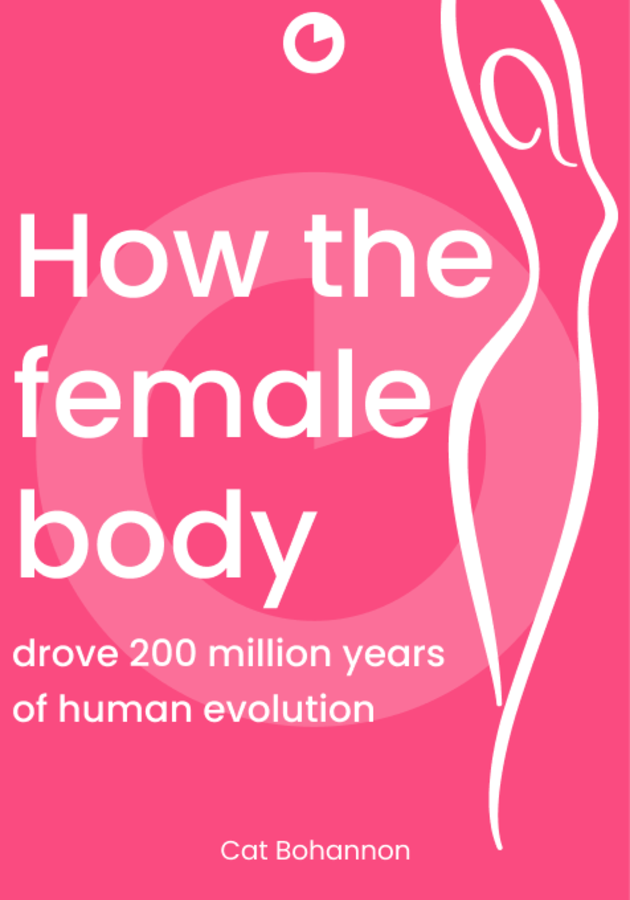A few million years ago, our ancestors were forced to leave the rainforest and exchange it for the savanna. According to William von Hippel, this move was probably the most significant event in the history of human evolution. Get ready to discover why.
Expelled from Eden
About six or seven million years ago, a group of chimplike creatures left the rainforest and moved to the savanna; we are their descendants. With hindsight, their decision might seem like the smartest in the history of civilization. After all, their grandchildren eventually evolved to become apex predators, builders of cities, inventors of language, creators of art, myths and rituals, explorers of the known and unknown universe. In their zoos, you can find the descendants of the chimplike creatures who remained in the trees. They are today’s great apes: the orangutans, the gorillas, and the chimpanzees.
But we only know this in retrospect. Six million years ago, the decision to leave the rainforest was an odd one. In the forest canopy, there is plenty of food and virtually no predators. Even superb tree climbers such as leopards don’t attack chimps in the trees. In the savanna, on the other hand, a chimplike creature – ungainly on two legs and slow on all four – is easy prey for any large cat. So, why did our ancestors leave the trees in the first place?
Well, the truth is they didn’t: it was the trees that left them. Tectonic activity along the East African Rift Valley caused changes in the climate and led to the drying of the rainforests on its east side. The chimplike creatures that lived there suddenly found themselves in an unkind environment, deprived of fruits and leaf buds, and surrounded by all kinds of dangerous predators. They likely spent the first few thousand years hiding, but for some reason, they were not happy with this solution. So, rather than eking out an existence in the savanna, they decided to become active contributors in their future destiny.
Change didn’t come overnight, but over the next three million years, these chimplike creatures learned to use their hands much better and started fending off predators by throwing stones at them. Soon enough, they discovered that – just as an individual can use stones to defend against predators – a group of individuals can hunt prey via “collective stone throwing.” The discovery changed absolutely everything.
Homo innovatio and homo socialis
In the 1950s, a Soviet geneticist by the name of Dmitry K. Belyaev decided to domesticate the Siberian silver-black fox. So, for the next four decades he kept selecting only friendly foxes for reproduction. What he discovered in the end was quite startling: selecting for sociability didn’t only affect the behavior of the foxes, but also their physical traits. The domesticated foxes had floppier, drooping ears, curlier tails, a shortened snout and even different coat colors. Most fascinatingly, they were a lot smarter than the wild silver-black foxes. Why? Three words: wheels on suitcases.
It doesn’t take a genius to invent the rolling suitcase – just as it doesn’t take an experienced traveler to know how practical a solution this is. And yet, believe it or not, no one thought to put wheels on suitcases until 1970! Blame it on the existence of porters whose job was, quite ironically, to put nonwheeled suitcases on a large cart with wheels and easily maneuver it through airports and bus stations. For decades, people had the solution right before their eyes. The reason why they didn’t see it was simple: they never considered it. Porters or friends helping out were satisfactory solutions by themselves.
Putting wheels on a suitcase is technical innovation; asking a friend or paying a porter to help you with your luggage is a social innovation. For a large part of history, scientists believed that humans evolved to become smarter because of technical innovations. By building or modifying tools for new purposes, they stimulated their brains; in turn, these new tools opened their brains to new connections. However, technical innovation is quite rare, even today. For most of our evolution, it was even rarer. Not because it required geniuses, but because most people focused their energies elsewhere – into social solutions to their problems.
Technological innovation is solitary and individualistic. Social innovation, on the other hand, means solving problems by leveraging social relationships. Spears and steel, for example, are technological innovations; money and myths are social. The hidden benefits of the latter far outweigh the perceptible benefits of the former. Because of myths and money and many similar innovations, people did not only become more connected and more friendly to each other, they also became a lot smarter. “Collective action,” concludes von Hippel, “brought about the cognitive revolution.”
Social challenges and the human brain
During the 1970s, British primatologist Jane Goodall studied the social and family life of the chimpanzees at the Gombe Stream National Park. One day, she observed an inconceivably gruesome act: two female chimpanzees called Passion and Pom killed and ate a three-week-old female infant, after savagely separating the girl from her mother Melissa. Though badly swollen and lacerated, Melissa reconciled with the two killers of her daughter not long after.
She was not the only female chimp to suffer the consequences of Passion and Pom’s terror: the two continued to kill and eat newborn infants for years. Being about as smart as human toddlers, the victimized mother-chimpanzees could not devise a successful strategy for dealing with the fearsome cannibals. None of them ever realized they could attack Passion and Pom in their sleep; none of them ever came up with the very obvious idea to ask for the help of another victimized mother and devise a proper group defense – if not a decisive collective attack. Chimps are very smart technological innovators – for example, they can hunt termites with sticks – but they are incapable of innovating anything socially. They just don’t have the brains for it.
By forming large collectives, our ancestors gave themselves the chance to develop solutions to these problems. “Ultimately,” writes Von Hippel, “dealing with fellow group members is a much greater mental challenge than manipulating objects. For this reason, many scientists have adopted the social brain hypothesis, which is the idea that primates evolved large brains to manage the social challenges inherent in dealing with other members of their highly interdependent group.”
Though chimps are bigger and stronger than us, their “technological brains” weigh only about 380 grams. The brain of Lucy, our 3 million-year-old Australopitecus afarensis grandmother, probably weighed about 70 grams more. Fast forward another 1.5 million years to Homo erectus, and you’re dealing with a large, 960-gram brain. The average weight of the brai n of the modern Homo sapiens is about 1,350 grams, or four times the weight of an average chimp brain!
The social leap into fierce egalitarianism
All in all, when our chimplike ancestors made the leap from the trees onto the savanna, they unknowingly made a fateful social leap that propelled them to the top of the evolutionary chain. Separated from the abundance of the rainforest, they now had to work together to survive and, since working together is not easy, they had no choice but to become social innovators. This transition from homo innovatio to homo socialis fundamentally altered their psychological makeup and the neural connections in their brains. As a result, they became a lot smarter. This allowed technological innovation to thrive, while maximizing the benefit to everyone’s wellbeing.
Thanks to their highly developed “social brains,” our hunter-gatherer ancestors found numerous smart ways to deal with difficult group members, ranging from communal ostracism to coalitional violence. Either way, bullies such as Passion and Pom repeatedly found the other members of the group banding together against them. Therefore, within-group physical conflict among hunter-gatherers slowly started disappearing. On average, chimpanzees are between 150 and 550 times more likely than humans to resort to physical aggression toward members of the same group. Our move from the rainforest to the savanna did not only make us smarter, but also much nicer to each other.
Finally, it made us very fierce egalitarians as well. For millions of years, our ancestors strongly resented anyone acting superior. Consequently, the most successful hunters constantly downplayed their skills; the bigger their catch, the more they deprecated their talents. Besides, hunter-gatherers constantly moved, so there was no effective way for them to store the surplus food. Stealing or hoarding could bring only short-term benefits for a skillful individual and wasn’t worth risking long-term complications, such as banishment upon discovery. So, sharing everything equally among the tribe was everyone’s best survival strategy. But then, about 12,000 years ago, agriculture arrived.
Amongst crops, cities and kings
With agriculture came settling down, and settling down was the best thing that could have happened for the talented and the hardworking. Now they could accumulate nicer homes and more stuff than the others. But so could the stronger, the wilier, the more ruthless, the less sensitive. These were probably the ones who started justifying their success by belittling the misfortunes of others. This was the first psychological step away from our hunter-gatherer lifestyle – “the willingness to agree that some people are better than others and that inequality is an acceptable outcome.”
However, once inequality became a “fact of nature,” societal hierarchies began multiplying, dividing people into rich and poor, kings and peasants, masters and slaves. The ones at the top soon found out that the best way to protect themselves from the potential dissatisfaction of their subjects was by introducing a common collective threat: nothing creates in-group solidarity as much as a common threat to this very day. This gave birth to the most general division of all – “us” vs. “them” – and to a strange, new belief in innate superiority.
These two led to all sorts of human suffering. Wars were rare before agriculture; legalized slavery, colonialism and scientific racism came only after. Paradoxically, since inequality demanded far more complex societal organizations than equality, with it, the number of laws and rules also increased, slowly but surely limiting the freedoms of the rulers and improving those of the ruled. Finally, the philosophers of the Enlightenment rediscovered individual rights and started advocating in their favor. Several centuries later, we are still in the quest to win them for everybody. Or better yet, to win them back – because hunter-gatherers had them for hundreds of thousands of years before the advent of agriculture.
Evolution and happiness
Just like homo sapiens in relation to individual human rights, let us also go back to the beginning of our story and ask what would have happened if the tectonic plates hadn’t moved along the East African Rift Valley 6 million years ago. The answer isn’t too difficult to guess: we wouldn’t have grown as intelligent as we have. Moreover, if rather than choosing to fight big cats with rocks, our chimplike ancestors decided to hide from them, we would have probably evolved similarly to baboons, whose solution to the dangers of savanna life was to group in large numbers to be more watchful and better defend themselves against predators.
However, our ancestors chose to face their problems head-on. For whatever reason, they seem to have been rarely satisfied, constantly wanting more and more out of life. That is why they became us. Their dissatisfaction drove them. Contrary to intuitive expectations, the more evolved a species is, the less happy it must have been in the past and the less its physiology is currently adapted for permanent peace and happiness. Hunter-gatherers remained living in stable societies for hundreds of thousands of years not because they weren’t smart enough to make technological breakthroughs, but because they had already found all the right social solutions to their immediate problems. So, they stopped bothering with progress.
The world, however, doesn’t belong to the perennially content. Evolution has programmed us differently. By providing us with temporary rushes of happiness, evolution has also supplied us with constant motivation to strive onward, toward the source of the next bliss. In a way, we have evolved so much not because we made all the right choices in the past, but because Mother Nature forced us to make many wrong ones. Leaving the rainforest was a mistake; saying “yes” to agriculture as well. Even so, by not choosing to look for short-term solutions to these issues, our ancestors turned them both into stepping stones to striking success. Otherwise stated, faced with a crossroads, they unwittingly took the path of relentless progress over that of lasting happiness. As a result, we, humans, conquered the world, but we grew less and less happy throughout the journey. Fortunately, there are still a few things we can do to find happiness within these evolutionary imperatives.
Getting to the good life in “10 easy steps”
Even though lasting happiness is a myth, in the words of Von Hippel, “approaching happiness from an evolutionary perspective can help us achieve it – at least some of the time.” The following 10 steps are neither easy nor a guarantee for success. But they can help you to at least understand happiness – if not more.
- Stay present. Humans alone, of all creatures, can turn over complex problems in their brains, imagining and simulating outcomes. That is great for dealing with cannibals such as Passion and Pom, but very bad for enjoying the present. There are neither dinosaurs nor saber-toothed tigers anymore. Take a deep breath. You are probably safe in the present. Try to live in it as often as possible.
- Seek out sweet moments. Nothing will make you permanently happier. Your biology works against you. So, instead of being sad about the impermanence of positive feelings, accept this as a fact of nature and enjoy them while they last. Have more fun in your life.
- Guard your happiness to stay healthy. Sacrifice your happiness only for short periods of time. Otherwise, you might wake up one day to find that you have done exactly what our chimplike ancestors did once upon a time: in trying to become successful, you forfeited your right to pleasure and sheer joy.
- Accumulate experiences, not stuff. “The great times you have become a part of you,” writes Von Hippel. “The great things you own gather dust or become trash.” Try to relive your great times as often as possible. If your memory doesn’t serve you well, your camera probably does.
- Prioritize food, friends, and sexual relationships. Von Hippel calls these three “the basis of day-to-day happiness” and describes them as “most likely to provide the happy experiences that accumulate into a life worth living.”
- Cooperate. To quote the author again, “your achievements won’t make you permanently happier, but cooperation is inherently rewarding and provides a foundation for life satisfaction.” After all, what is the point of achieving anything if you have nobody to share it with, if people are envious and jealous of your success, rather than being happy for it?
- Embed yourself in your community. Yes, we evolved to be curious, but we also evolved with a strong sense of community belonging. Never, ever abandon your roots without giving it careful thought first. And even if you do, retain connections.
- Learn new things. Since we opted for progress in lieu of happiness, evolution has programmed us to enjoy the process of mastering new things – especially through play, interactive participation and storytelling. Choose your spheres of interest carefully, and you can probably reap manifold benefits up to the last healthy days of your life.
- Play to your strengths. Don’t remain stuck too long with a certain job or a certain hobby. Change is frightening, but it is a part of life. The moment something you love stops giving you pleasure – adapt. Your dissatisfaction is evolution telling you that you must change your life.
- Seek the original source. TV and movies are not as bad as they are made out to be – they actually mimic some original sources of pleasure for our ancestors such as endless stories and communally shared myths. However, they are not the real thing. Alcohol, drugs and junk food are substitutes for the real thing as well: they too short-circuit our pursuit of happiness by indulging our brains into mimicked ancient pleasures “without delivering the outcomes that made those ancient activities adaptive and hence pleasurable.” Playing football with your teammates will always be better than watching it on TV; watching “Friends” will always be less enjoyable than having friends. Don’t let surrogates fool you into cravings and dependances. Seek the original source of pleasure instead.
Final notes
In the vein of Jared Diamond’s “Guns, Germs, and Steel” and Yuval Noah Harari’s “Sapiens,” “The Social Leap” is a fine addition to the ever more popular Big History genre.
Engrossing, enjoyable, enlightening – and strangely applicable!
12min tip
Read some other Big History books, such as the two just mentioned. They should help you see the big picture. It gets easier to work out the minor details afterward.





























